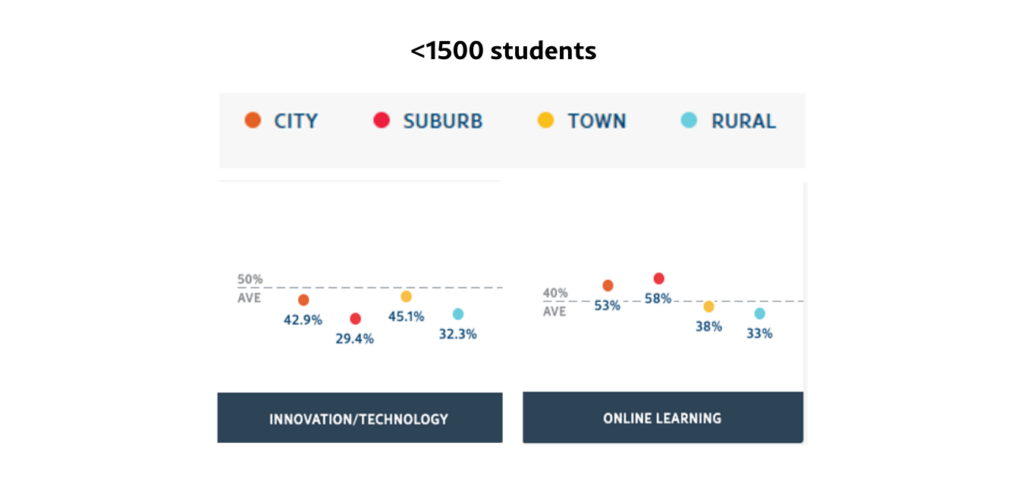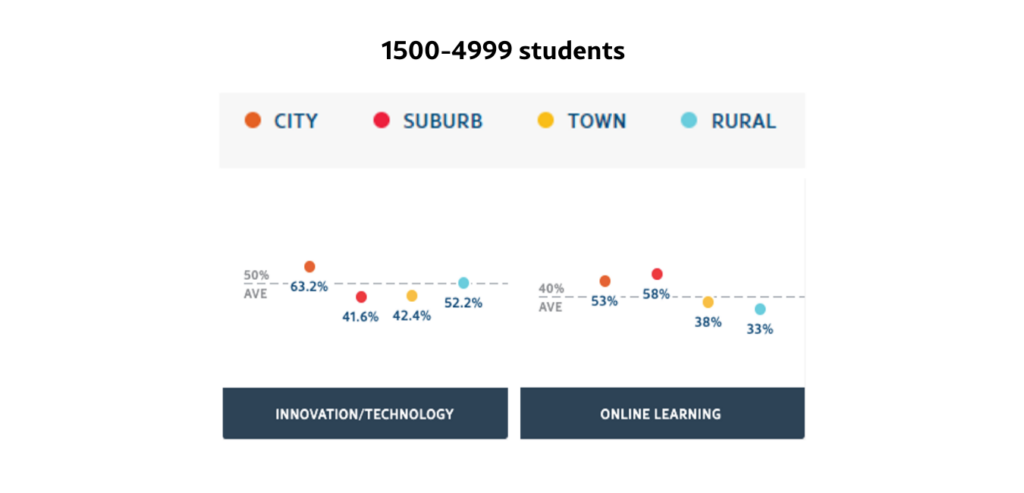As a managed services provider with more than 20 years focused solely on higher education, Apogee talks with school leaders and administrators all over the country daily. From small, regionally focused institutions to large public schools, we’ve learned about how higher ed leaders see the world and their place in it. We routinely use what we’ve learned (and learn) to help Apogee partners realize their vision and goals.
We also spend a lot of time thinking about what we can do to serve our customers better. As true partners in higher education, we believe it’s our purpose to help customers make data-driven planning decisions and explore how technology can create successful outcomes for their most essential institutional initiatives.
Before meeting with a new potential client, our team makes it a best practice to review the school’s strategic plan. By early this year, we had read 491 publicly available strategic plans of higher ed institutions across the country. We then put our data scientist to work analyzing them all to find common themes and actionable insights. We also appended IPEDS data to properly categorize institutions by size and locale. The goal: to better understand what schools, both big and small, reflected as priorities in a pre-pandemic world. We published a summary of our initial findings in July.
Today we launch an interactive version of our report with all the precise data to help higher ed leaders like you uncover gaps and opportunities in your strategic plans as you look to build agile strategies for 2021 and beyond.
At the highest level, the interactive report examines institutional emphasis and investment across seven strategic initiatives: student outcomes, technology, pedagogy, student life, funding, population, and governance. We further segment the data by IPEDS locale type (rural, town, suburb, and city) and student enrollment (<1500, 1500-5000, and 5000+) to help you better identify your particular peer, aspirational, or competitive set.
The interactive report includes a section that drills down into the data a step further. Here, we’ve taken the seven initiatives listed above and indexed 16 sub-initiatives. For those unfamiliar, “indexing” is a marketing term that answers how a group differs from a larger population. The data is presented in easy-to-read charts that show the average for all 491 institutions and then compare the different groups based on size and locale to see which groups are average, over-index, or under-index. From student success to student engagement, technology and innovation, online learning, residential living, and a lot more, these sub-initiatives offer a finely detailed and highly actionable view of what we’ve learned.
So, what’s the headline?
The truth is, one could spend hours looking at the interactive report data, and I’ll be blogging quite a bit about the many findings. Today, we’ll start with several vital takeaways that got my attention as the interactive report came to life. None were more surprising to me than this one: over the last ten years, technology initiatives trail those focused on pedagogy by 76% to 71% pre-2015 and 83% to 64% post-2015 across all strategic plans reviewed. We would expect technology initiatives to increase over time, in parallel with increases in pedagogy. Instead, our data clearly shows that emphasis on technology shrank while pedagogical initiatives persisted at an increasingly high level.
The disconnect is even more pronounced when we look at small/medium schools (<5000 students). Here, the ratio of pedagogy to technology investment lags behind large institutions by 28 points. Let’s think about this in practical terms. In the early days of the pandemic, when schools were forced to pivot to online learning almost overnight, large schools made the shift more easily than their smaller school competitors. One could argue technology investment, laid out in institutional strategic plans, had been executed and made the difference.
This is a pretty important point given the higher ed landscape today. Blended learning is rapidly shifting from a short-term pandemic-driven solution to a long-term differentiator and value creator. The data suggests many schools were vulnerable and unprepared to manage the rapid change to remote learning.
Now, let’s dig into more details.
In the 16 sub-initiatives section of the interactive report, we break down the strategic plan inclusion of these by school size in each of our four locale types. A dropdown menu lets you choose the school size most relevant to you: <1500, 1500-4999, and 5000+. A quick side note: you’ll want to set aside some time to really check out this section – it’ll be well worth your time as you scan these charts to compare your campus.
A couple of data points quickly rise to the surface when you compare technology and online learning initiatives. First, knowing that the average is based on the total population of 491 schools we studied, we see a lack of alignment between innovation/technology investment and online learning. For example, schools <1500 students in rural areas come in third on technology initiatives and last on online learning initiatives, trailing the other locales by 5-25 points. Meanwhile, this <1500 group in the suburbs comes in last on technology initiatives but are first in online learning initiatives. See the figure below:

Simultaneously, rural schools in the 1500-5000 student range over-index in innovation/technology while significantly under-representing in online learning. Institutions in the suburbs under-index on innovation/technology, in the last place at 41.6% versus an average of 50% for all groups. But, like schools <1500, they are first in online learning initiatives, coming in at 58% again versus an average of 40% for all groups. See the figure below:

So, what does all of this mean??
As blended learning becomes a core part of your vision and strategy, the role of your IT organization is evolving from that of a cost center to a critical contributor to your school’s mission. The ability to interact with this strategic planning data by school size and locale type can help you benchmark where things stood pre-pandemic and whether your strategic plan was average, over-indexing vis-à-vis school like yours, or whether you may have missed some strategic imperatives. If you’re a small school in a rural area, you may want to look at how your 2021 plan can better align technology and pedagogy and whether you are at a disadvantage currently. While the data here suggests there is more to do to better align investments in technology with your goals for pedagogical improvements, the data likewise indicates a misalignment of technology investment with the initiatives most critical to a blended learning future. Higher ed must become more nimble and agile and not miss the opportunity to plan NOW.
A good strategy doesn’t come only from research and benchmarking, but we hope you’ll spend some time with the interactive report to help refine and strengthen your strategic plans. We’re available to Zoom with you to help you benchmark your current plan with those of schools similar to yours.
Discomfort is part of the strategic planning process, so I would encourage you to take a deep dive into the data, engage with us at Apogee and ask us questions, and think about how this data relates to your mission, your operations, and, most importantly, your students. Focus on them, knowing that strategic planning is about making some bets but articulating the logic behind those choices.
To learn more about how blended learning can help you differentiate and win, read our Apogee white paper, Transform the Educational Experience through Blended Learning. To request a Zoom or phone call to talk through the data in the interactive report, please email us at sales@apogee.us.
Author Bio
Teresa de Onis joined Apogee in 2019 and is a 25-year Austin marketing veteran with marketing expertise in distance learning systems, IT, and higher education. She combines strategy and storytelling to create and execute compelling and authentic value propositions, communication plans, brand architectures, sales enablement plans and tools, campaigns, and customer experience journeys. Teresa holds an MBA, BA, and certificate in change management, all from the University of Texas at Austin.





